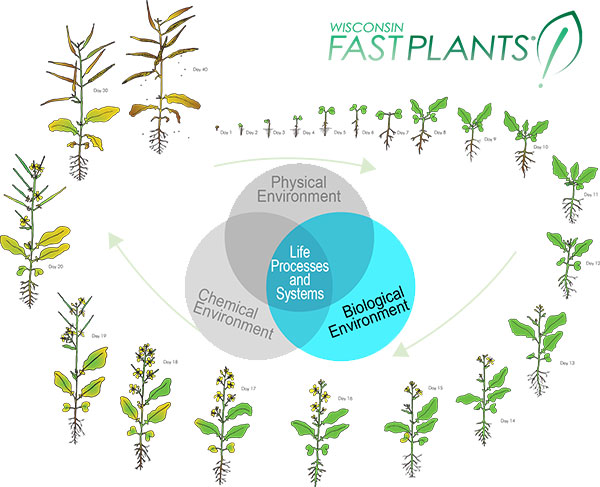Environment plays a key role in how your Fast Plants grow and develop through their life cycle. Classifying environmental factors into three broad groups can be useful for studying their effects: 1) the physical environment, 2) the chemical environment, 3) the biological environment. This post is part of a series that explains how key environmental factors can impact plants. We focus here on biological factors and Wisconsin Fast Plants.
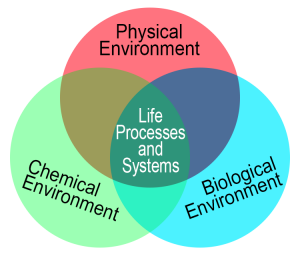
Growing Environment Factors
Our website describes what ideal growing conditions are for growing Fast Plants. These conditions come from more than 25 years of science and engineering practices, working with Fast Plants. Sometimes you may want to keep your Fast Plants growing in an ideal biological environment to test variables in the physical or chemical environments. Or perhaps, you’ll design a test to see how changing a factor in the biological environment affects germination, growth, or reproduction. Whether you want to grow Fast Plants in ideal conditions or you’re designing an experiment, this post can help. We address four factors in the biological environment that are easy to control:
- Competition and companion plants
- Fungi and bacteria pathogens
- Algal growth that can hinder plant health
- Insects and herbivores
Biological Environment Factors
Competition and Companion Plants
Plants seldom grow in isolation from other plants. Even Wisconsin Fast Plants typically have a few extra seeds planted in each container. Consequently, if seedlings grow without thinning, the young Fast Plants compete for light, nutrients, and root space.
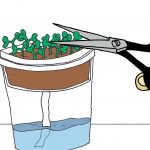
Seedlings are typically thinned to reduce competition for light, nutrients, and root space.
On the other hand, research into plant communication is revealing how plants can benefit from communication received from neighboring plants. Additional research explores how plants may in some cases assist other plants to obtain water or nutrients.
Therefore, nearby plants of the same and different species can limit growth and development in some instances, and support healthy growth and development in other cases.
Fungi and Bacteria
 Fungi and bacteria are important parts of the biological environment, and most are beneficial. Some beneficial fungi and bacteria are found in association with seeds. Others live in healthy soils and benefit root growth and water or nutrient uptake. Many are yet to be discovered or understood.
Fungi and bacteria are important parts of the biological environment, and most are beneficial. Some beneficial fungi and bacteria are found in association with seeds. Others live in healthy soils and benefit root growth and water or nutrient uptake. Many are yet to be discovered or understood.
On the other hand, troublesome fungi or bacteria that cause diseases in plants also exist. We classify these as plant pathogens. Above ground, fungi and bacteria pathogens typically cause problems only if humidity is greater than 95% or airflow is poor. Below ground, fungal or bacterial infections can occur when roots are growing in poorly drained growing medium.
Therefore, the best controls for fungi and bacteria pathogens are keeping materials clean and well aerated. To start, we recommend planting in a pathogen-free growing media. Most commercially available seed-starter mixes are sanitized and pathogen-free. Choose a well aerated growing medium, and then keep it well aerated and drained. Two important ways to way to do this are:
- Avoid packing the growing media during planting.
- Use a wicking growing system so that water is drawn into the growing medium as needed.
Further, sterilize all growing materials before re-using them (pots, reservoirs, capillary mats and wicks). Do this by soaking everything for at least 30 minutes in a 10% chlorine bleach solution. Then rinse thoroughly before replanting. In addition, always start with fresh, sterilized growing media (soil-less seed starter mix).
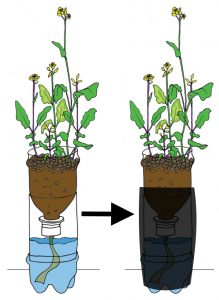
Darkening the water reservoir by spray painting or covering with black plastic helps control pests of the biological environment, most notably, algae!
Algal growth – prevention and control
Like bacteria and fungi, algae are important factors in the biological environment. Most algae cause no harm to plants. However, algal growth in water reservoirs can cause wicks to stop working and limit airflow to roots. Limit algal growth by making the water reservoir dark. Dark water reservoirs keep out light, and without light, algae cannot live. Water reservoirs can be spray painted black or a dark cover can be wrapped around the reservoir (use aluminum foil or strips of black trash bags).
Alternatively, adding copper sulfate (CuSO4•5H2O) to the water in the reservoirs inhibits algal growth. At most, add copper sulfate enough such that the final concentration in the reservoir is between 5 and 25 parts per million (milligrams/liter).
In addition, algae can develop on the growing medium surface. Heavy concentrations of surface algae can cause plants to grow poorly or die. Young seedlings are the most susceptible to harm.
Good airflow is the best deterrent for surface algal growth. One way to promote surface aeration if you spot surface algae is to use a toothpick or skewer to rough-up the growing medium surface. As a result, the surface will dry and algae cannot form a dense mat. Also, aiming a fan to blow air gently across your Fast Plants can help.
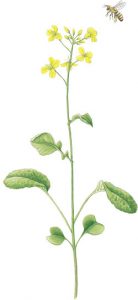 Insects
Insects
Wisconsin Fast Plants–like many flowering plants–depend on insects to transfer their pollen. Fast Plants can only rarely reproduce successfully without cross-pollination. Consequently, relationships are critical between Fast Plants and bees and other pollinators who are part of the biological environment.
However, because Wisconsin Fast Plants grow indoors where beneficial insects are uncommon, most insects encountered are pests. Daily surveillance and removal of insects is the best practice. Fortunately, large invasions of insect pests are rare in classrooms.
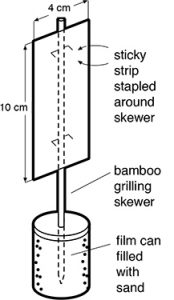
Weighted stand for yellow sticky trap
Sticky yellow pest control cards work well to trap incoming insects
and flies or gnats emerging from the soil. These sticky strips are available at many garden centers. Some traps come with a wire or wooden skewer that is easy to poke into a growing system or mount in a weighted stand (see line drawing) Place the traps among your plants, and monitor the insects trapped. Additionally, sticky traps 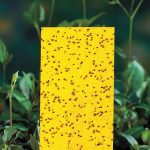 are effective for controlling white flies, aphids, fungus gnats and thrips.
are effective for controlling white flies, aphids, fungus gnats and thrips.
Fast Plants may also be sprayed with insecticidal soap or another safe chemical control agent. Be sure to read labels carefully before applying chemicals. Again, surveillance and careful removal by hand is always best.
Few large herbivores trouble Wisconsin Fast Plants because they’re grown indoors. However, investigations into the relationship between herbivores like the cabbage white moth (Pieris rapae) and Fast Plants (Brassica rapa) are rich with possibilities. You’ll find a video about the cabbage white butterfly life cycle on our YouTube channel.
Summary
In conclusion, some factors in the biological environment benefit plant systems and processes, and others cause harm or limit growth and development. Furthermore, we still have much to learn about the relationships among many biological factors. And even more complex are the myriad relationships among biological, physical, and chemical factors. Together, these factors influence systems at many scales, including individual plants and plant populations, communities, and ecosystems.
Thanks for reading! Be sure to check out the posts focusing on factors of the physical environment and chemical environment!

